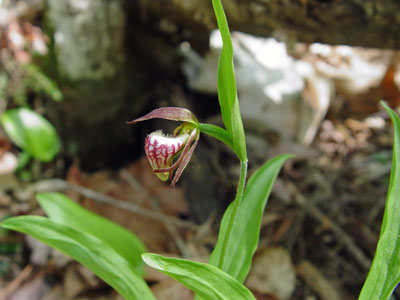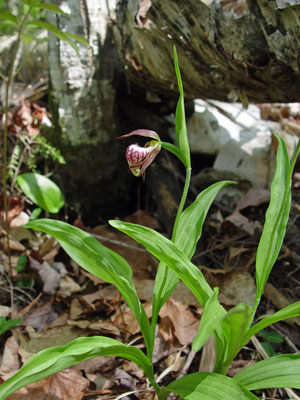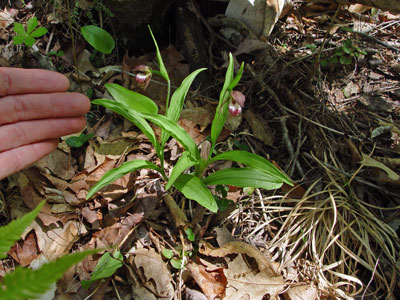DACF Home → Bureaus & Programs → Maine Natural Areas Program → Communities, Plants, and Animals → Rare Plants → Cypripedium arietinum

Cypripedium arietinum Ait. f.
Ram's-head Lady's-slipper
- State Rank: S1
- Global Rank: G3
- State Status: Endangered
Habitat: Damp or mossy woods or bogs. [Conifer forest (forest, upland); Forested wetland; Hardwood to mixed forest (forest, upland)]
Range: Southeastern Canada south to New England and west to Minnesota.

Aids to Identification: Cypripedium arietinum is the smallest and rarest lady slipper growing in Maine. Ram's-head lady's-slipper is unique from other lady's slippers by having three separate sepals rather than two. A single flower tops the leafy stalk. The lower lip is whitish strongly veined with red, and is reduced downward to a blunt conical pouch; viewed from the side this resembles a ram's head.
Ecological characteristics: Ram's-head lady's-slippers are found very locally in mixed woods or open stands of northern white cedar, growing in moist, sandy or loose soil sites in well drained situations in partial shade, at relatively low elevations. It can be found with various native plants in different locations including star flower (Trientalis borealis), twin-flower (Linnaea borealis), bellwort (Uvularia sessilifolia), bunch-berry (Cornus canadensis), ferns, and occasionally in cedar bogs with pitcher plant (Sarracenia purpurea) and various shrubby heaths.

Phenology: Flowers in late May to early June.
Family: Orchidaceae
Synonyms: None noted.
Distribution in Maine: This rare plant has been documented from a total of 16 town(s) in the following county(ies): Androscoggin, Aroostook, Cumberland, Hancock, Kennebec, Oxford, Penobscot, Somerset, York.
Reason(s) for rarity: Rare and declining throughout its range perhaps due to loss of habitat through succession, development, or in some cases indiscriminate timbering. Occurs (and is rare) in all New England states except Rhode Island.
Conservation considerations: Orchids are popular among some speciality gardeners, and populations of this species are vulnerable to unscrupulous or uneducated collectors. Plants dug from the wild usually do not survive; more importantly, removing these plants harms the natural population and may cause its eventual disappearance. This plant is not known to have been successfully propagated, and any plants offered for sale have almost certainly been collected from the wild. Effects of logging are not well known, but partial removal of the canopy may be beneficial as long as subsequent undergrowth is not allowed to overgrow the plants.